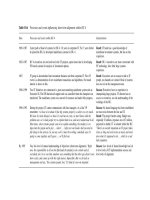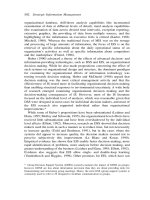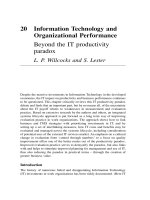Managing information systems 7th edition brow ch02
Bạn đang xem bản rút gọn của tài liệu. Xem và tải ngay bản đầy đủ của tài liệu tại đây (954.72 KB, 65 trang )
MANAGEMENT INFORMATION SYSTEMS
CHAPTER 2
COMPUTER SYSTEMS
-HARDWARE
-SOFTWARE
Copyright © 2012 Pearson Education, Inc. publishing as Prentice Hall
2-1
HARDWARE
Chapter 2
Copyright © 2012 Pearson Education, Inc. publishing as Prentice Hall
Chapter 2
Chapter 3
Chapter 4
2-2
COMPUTER SYSTEMS
•
Hardware:
Physical pieces of a computer system
•
Software:
Set of programs that control the operations of a computer
Copyright © 2012 Pearson Education, Inc. publishing as Prentice Hall
2-3
BASIC COMPONENTS OF COMPUTER SYSTEMS
•
All computers made up of the same set of six building
blocks: input, output, memory, arithmetic/logic unit,
control unit, and files
•
Control unit and arithmetic/logical unit together known
as the central processing unit (CPU)
Copyright © 2012 Pearson Education, Inc. publishing as Prentice Hall
2-4
BASIC COMPONENTS OF COMPUTER SYSTEMS
Copyright © 2012 Pearson Education, Inc. publishing as Prentice Hall
2-5
BASIC COMPONENTS OF COMPUTER SYSTEMS
Input:
•
Device(s) needed to enter data into the computer
for it to use in computations and comparisons
Copyright © 2012 Pearson Education, Inc. publishing as Prentice Hall
2-6
BASIC COMPONENTS OF COMPUTER SYSTEMS
Input: What is the difference between a terminal and a PC?
•
Terminal
-
Designed strictly for input and output
Has keyboard and screen
Does not have a processor
Connected to a computer with a processor via telecommunications
- Examples: point-of-sale terminal, ATM
Copyright © 2012 Pearson Education, Inc. publishing as Prentice Hall
2-7
BASIC COMPONENTS OF COMPUTER SYSTEMS
Common Input Methods:
-
Keyboard: input entered by user through keystrokes
Mouse, stylus, touchpad: alternative to keystrokes
Disk drive or flash drive: data on disk read into memory
Magnetic ink character recognition (MICR): used to process bank checks
Barcode labeling: scans barcodes on packages or products, and reads into computer
Optical character recognition (OCR): directly scans typed, printed, or handwritten material
Imaging: inputs digital form of documents and photos
Keyboard
Disk Drive
Barcode
Copyright © 2012 Pearson Education, Inc. publishing as Prentice Hall
2-8
BASIC COMPONENTS OF COMPUTER SYSTEMS
Output:
•
Device(s) needed to produce results in a usable
format
Copyright © 2012 Pearson Education, Inc. publishing as Prentice Hall
2-9
BASIC COMPONENTS OF COMPUTER SYSTEMS
Common Output Methods:
- Video display unit: displays output on a screen
- Disk drive or flash drive: output written to disk for storage
- Printer: output to paper (various types of printers)
- Computer output microfilm (COM): microfilm generated for archive copies in small space
- Voice response units: computer-generated verbal response messages
Video Display
Disk Drive
Microfilm
Copyright © 2012 Pearson Education, Inc. publishing as Prentice Hall
2-10
BASIC COMPONENTS OF COMPUTER SYSTEMS
Memory:
•
•
•
-
Referred to as main memory or primary memory
All data flows to and from memory
Divide into cells
Each has a unique address
Can only store limited amount of data
-Byte: stores one character of data
-Word: stores two or more
characters of data
Memory
Copyright © 2012 Pearson Education, Inc. publishing as Prentice Hall
2-11
BASIC COMPONENTS OF COMPUTER SYSTEMS
Memory:
Copyright © 2012 Pearson Education, Inc. publishing as Prentice Hall
2-12
BASIC COMPONENTS OF COMPUTER SYSTEMS
Memory:
•
•
•
•
•
Each memory cell is a set of circuits
Each circuit is on or off (represented by 1 or 0)
Each circuit corresponds to a bit (binary digit)
Most computers – 8 bits (circuits) represents a character (byte)
2 common bit coding schemes used today:
- ASCII
- EBCDIC
Copyright © 2012 Pearson Education, Inc. publishing as Prentice Hall
2-13
BASIC COMPONENTS OF COMPUTER SYSTEMS
Arithmetic/Logical Unit:
•
Carries out:
- Mathematical operations (addition, subtraction,
multiplication, division)
- Logical operations (number comparisons)
Copyright © 2012 Pearson Education, Inc. publishing as Prentice Hall
2-14
BASIC COMPONENTS OF COMPUTER SYSTEMS
Arithmetic/Logical Unit:
•
•
•
Consists of VLSI circuits on a silicon chip
Can perform up to billions of operations per second
Numbers are taken from memory as input and results are stored in memory as output
ALU Circuits
Copyright © 2012 Pearson Education, Inc. publishing as Prentice Hall
2-15
BASIC COMPONENTS OF COMPUTER SYSTEMS
Computer files:
•
•
•
File devices used to store vast quantities of data
Main memory is limited, volatile and expensive
Advantages:
- File devices or secondary memory are used to store additional
data that is non-volatile
•
Disadvantages:
- It has relatively slow speed
•
-
Storage Devices:
Magnetic tape drives, disk drives, floppy drives
Optical CD or DVD drives
Copyright © 2012 Pearson Education, Inc. publishing as Prentice Hall
2-16
BASIC COMPONENTS OF COMPUTER SYSTEMS
Types of Computer files:
•
Sequential Access Files
•
Records are stored in sequence according to file’s control key
Usually stored on magnetic tape
Direct Access Files
-
Records can be accessed immediately, without regard to physical location
Stored on Direct Access Storage Devices (DASD)
Copyright © 2012 Pearson Education, Inc. publishing as Prentice Hall
2-17
DIRECT ACCESS STORAGE DEVICES
•
Types of DASD:
•
Fixed (hard) drives
•
Optical disk storage
•
- CD-ROM
- DVD-ROM
- CD-R
- DVD-R
- CD-RW
- DVD-RW
Removable drives
- Floppy Drives
- Zip Drives
- Flash (keychain) Drives
Copyright © 2012 Pearson Education, Inc. publishing as Prentice Hall
2-18
BASIC COMPONENTS OF COMPUTER SYSTEMS
Control unit:
•
Controls the other five components of the computer
system
•
Used to take advantage of speed and capacity of
other components
•
List of operations, called a program, tells the
control unit what to do
•
These operations are read from memory,
interpreted, and carried out one at a time (storedprogram concept)
Copyright © 2012 Pearson Education, Inc. publishing as Prentice Hall
2-19
STORED-PROGRAM CONCEPT
•
Computer Program
- A list of what is to be done for an application
- Each step or operation is called an instruction
•
Machine Language
- Computer program written for specific computer model
- Program executed by control unit; consists of operation code and addresses
•
Measure of Computer Power
- Millions of instructions per second (MIPS)
•
- Millions of floating point operations per second (MFLOPS)
Benchmarking is used to compare speed for running a set of jobs on
Copyright © 2012 Pearson Education, Inc. publishing as Prentice Hall
different machines
2-20
TYPES OF COMPUTER SYSTEMS
Copyright © 2012 Pearson Education, Inc. publishing as Prentice Hall
Table 2.1
2-21
TYPES OF COMPUTER SYSTEMS
Microcomputers:
•
•
•
For personal computing
Can generally be carried or moved by one person and only have one keyboard and display unit
Examples:
- Desktop PC
- Laptop or notebook
- Handheld or personal digital assistant (PDA)
- Tablet PC
Copyright © 2012 Pearson Education, Inc. publishing as Prentice Hall
2-22
TYPES OF COMPUTER SYSTEMS
Microcomputers:
Copyright © 2012 Pearson Education, Inc. publishing as Prentice Hall
2-23
TYPES OF COMPUTER SYSTEMS
Microcomputers, continued:
•
•
Two major microcomputer platforms
-
IBM-compatible PCs (personal computers)
Apple microcomputers (does not use Windows OS)
Have been put to a myriad of uses
-
Record-keeping
Word processing
Presentations
Programming
and a “client” in a client/server system
Copyright © 2012 Pearson Education, Inc. publishing as Prentice Hall
2-24
TYPES OF COMPUTER SYSTEMS
Midrange systems:
•
In 1980s, included 2 types of computer systems
1. Workstations
-
Microcomputers with more powerful chips than PCs
- Reduced instruction set computing (RISC) chip yielded greater performance because it was specialized
2. Minicomputers
- Less powerful and less expensive than mainframe systems
- Used for departmental computers & office automation
Midrange Systems
Copyright © 2012 Pearson Education, Inc. publishing as Prentice Hall
2-25









